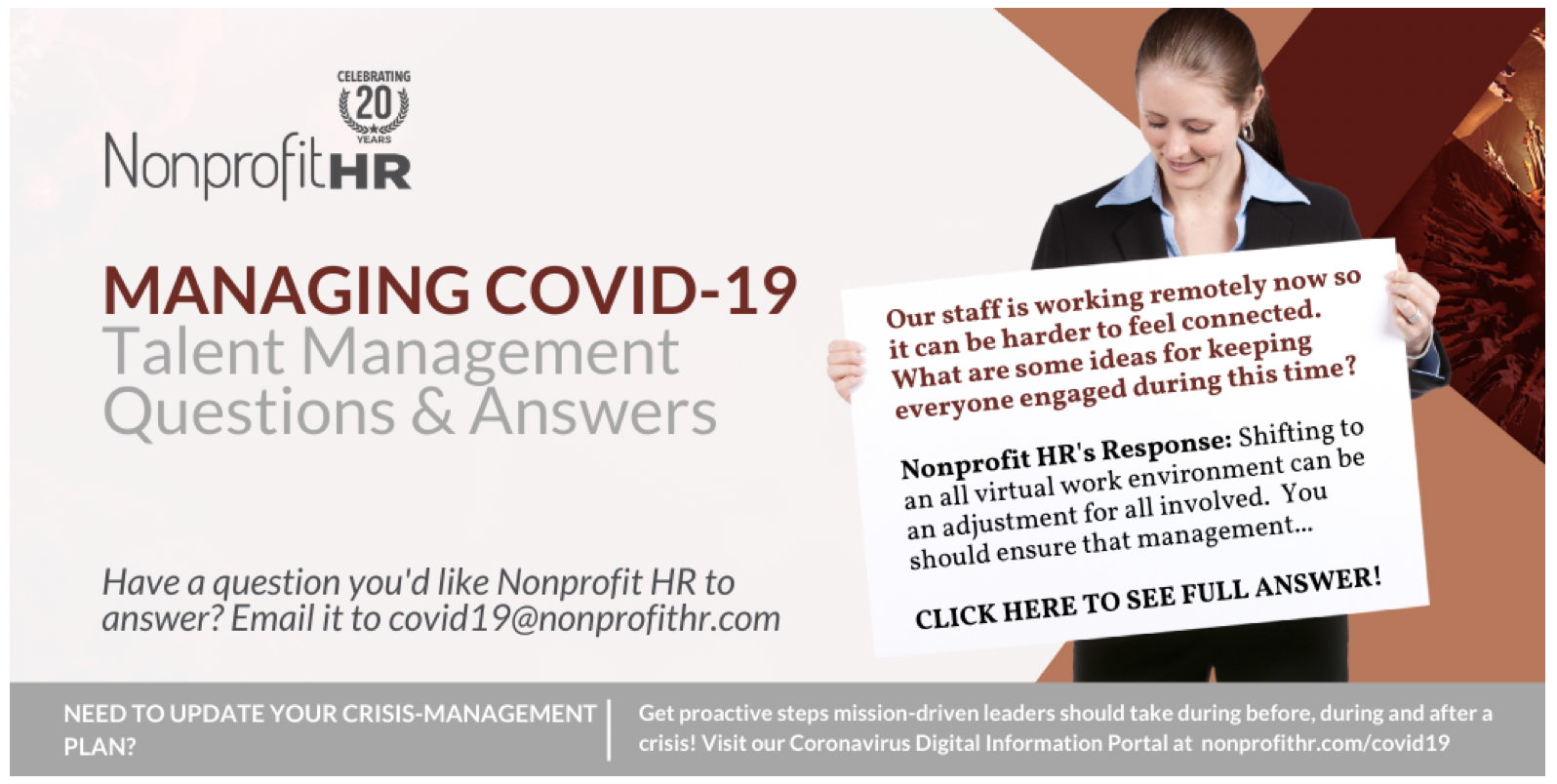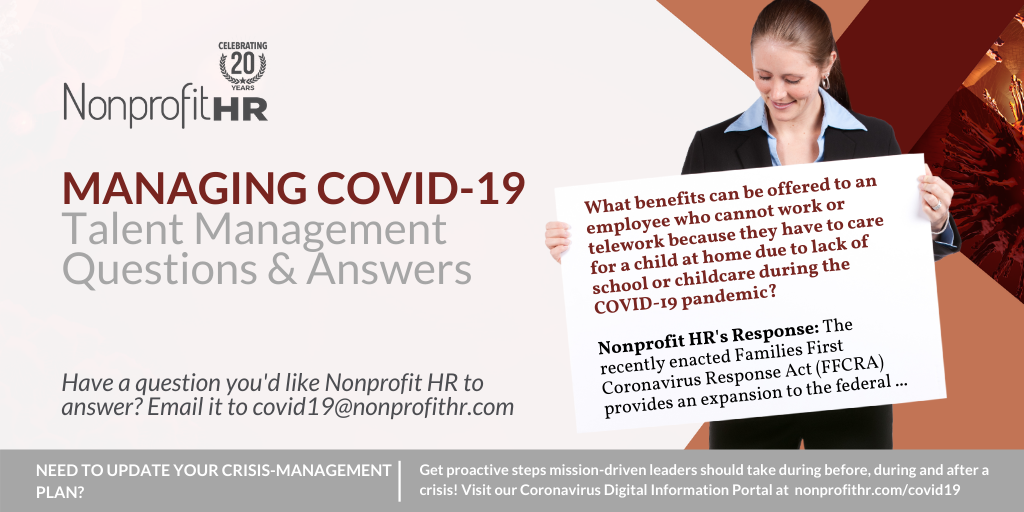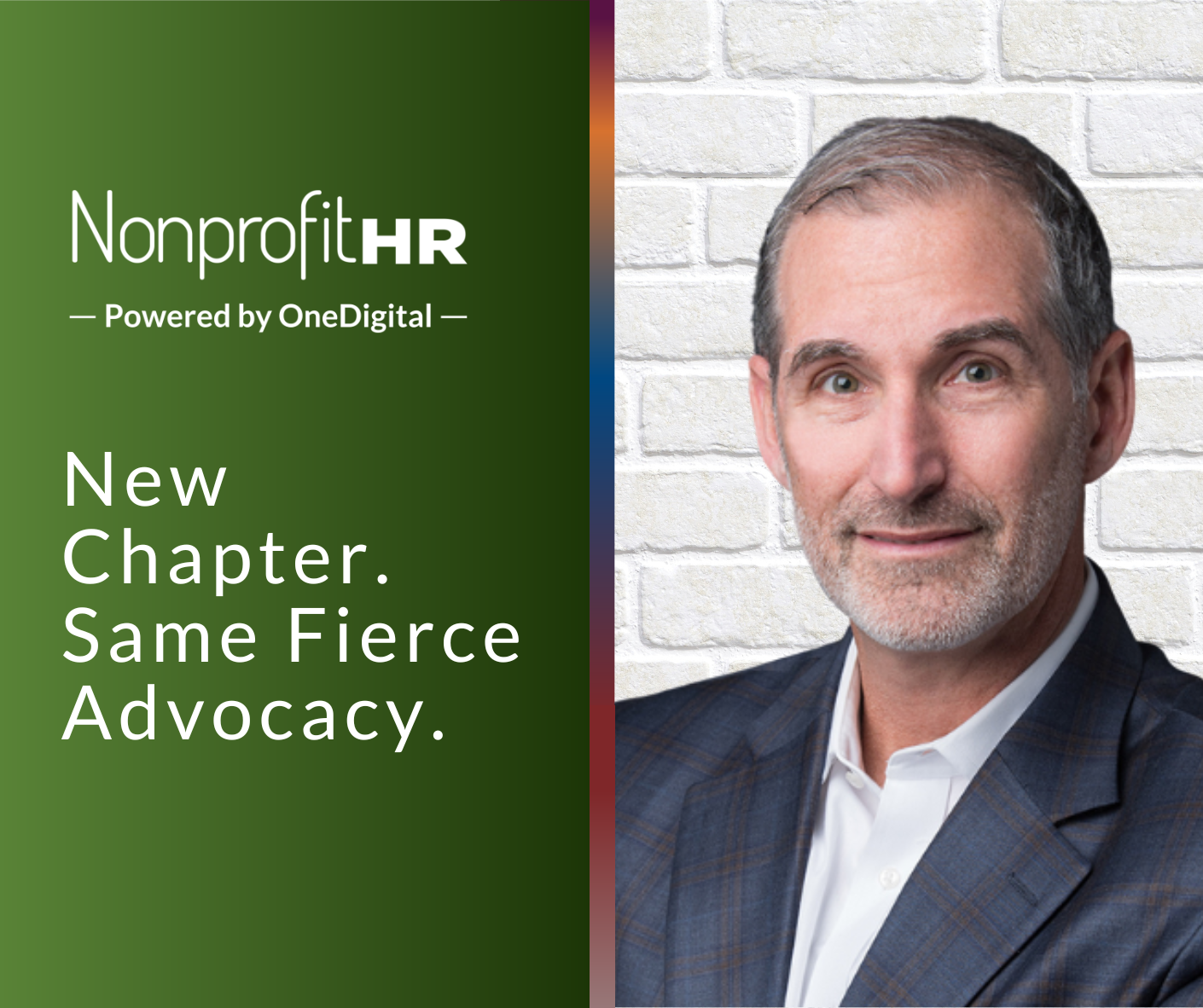WTOP: 5 ways nonprofits can…
Nonprofit HR has received many questions from social impact organizations and has decided to share our responses with the public. Visit this page daily to see new questions and answers your peers are asking.
Have a question you’d like Nonprofit HR to answer? Email it to [email protected].
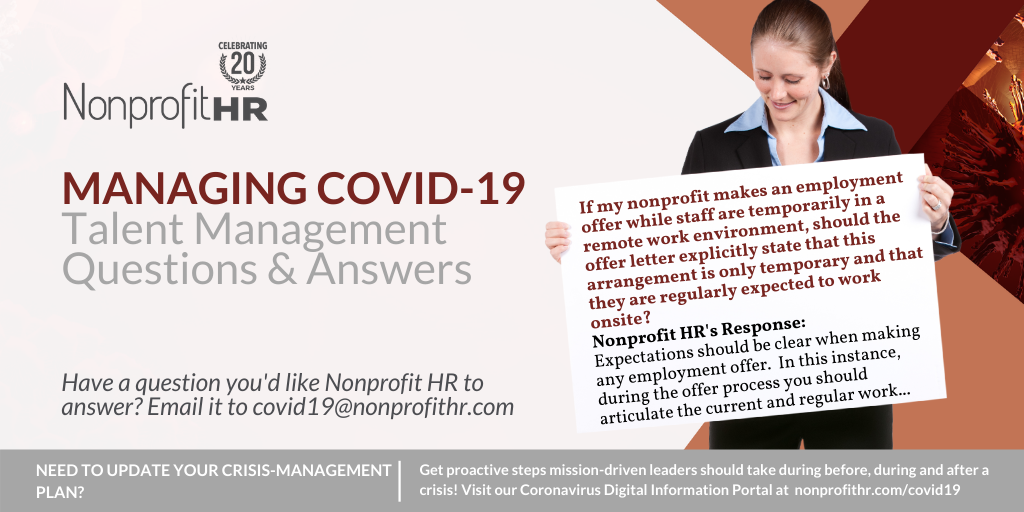
Nonprofit HR’s Response: Expectations should be clear when making any employment offer. In this instance, during the offer process you should articulate the current and regular work policies that are in place and whether or not the position is a remote position under regular circumstances. Given the fluidity of the current pandemic situation your needs and policies will likely shift, but the new hire should know what to expect. These expectations may be shared in the offer letter or an email that accompanies the offer letter, but be mindful of employment-at-will laws and the changing needs of your organization. As a good practice, we advise you discuss this with your employment counsel.
Recent Questions

Nonprofit HR’s Response: A furlough is a temporary reduction in or elimination of staff hours. Typically the employer plans to reinstate the employee after a period of one to two months. It is important to be mindful that exempt staff’s wages may only be reduced in full-week increments and the furlough or salary reduction should be documented in a memo to the employee. While employers may consider enabling employees to use or apply accrued vacation and sick leave to make themselves “whole” during a furlough, doing so does undermine the benefit of decreasing payroll expenses. An employer may also allow an employee to continue their health insurance during this period or should otherwise offer continuation under COBRA.
A layoff is a formal separation from employment when the need is not temporary. An organization may choose to provide severance or other separation benefits, typically in exchange for a waiver and release as documented in a separation agreement. The organization should provide the opportunity to continue health insurance under COBRA regulations.
Question: Our staff is working remotely now so it can be harder to feel connected. What are some ideas for keeping everyone engaged during this time?
Nonprofit HR’s Response: Shifting to an all virtual work environment can be an adjustment for all involved. You should ensure that management communicates regularly with staff and that opportunities to interact similar to those in the office setting take place. Using video or chat tools for communication helps to provide regular or scheduled opportunities for staff to touch base with managers or colleagues.
It is also important to provide opportunities for virtual social interaction among staff during this time of social isolation and anxiety. Virtual lunch gatherings or end-of-week socials are great ways to provide your staff with an informal way of visiting with their colleagues. Focusing on your staff’s overall well-being and ensuring a strong culture is just as important in a virtual work environment as it is when you are in your physical office environment.
Question: What benefits can be offered to an employee who cannot work or telework because they have to care for a child at home due to lack of school or childcare during the COVID-19 pandemic?
Nonprofit HR’s Response: The recently enacted Families First Coronavirus Response Act (FFCRA) provides an expansion to the federal Family and Medical Leave Act.
Under FFCRA, employees unable to work or telework due to a need to care for a child under age 18 (if the child’s school or place of childcare is closed or unavailable as a result of the COVID-19 health emergency) are eligible for up to 80 hours of emergency paid sick leave to be paid at 2/3 of the employee’s regular rate of pay (daily rate cannot drop below minimum wage). Sick leave taken for these reasons is capped at $200/day ($2,000 for total duration of leave). Part-time employees are eligible for leave based on the number of hours they are regularly scheduled to work over that period. (Note: Paid leave emergency sick leave is also provided for other COVID-19 related reasons.)
FFCRA also provides job protection and up to 12 weeks of emergency paid family leave for employees who have been employed for at least 30 calendar days and are unable to work or telework for the reason stated above. Leave will be paid at 2/3 of the employee’s regular pay rate for the hours the employee would have otherwise normally been scheduled to work. Leave payments are capped at $200/day per employee ($10,000 for total duration of leave – remainder of the 12 weeks of paid leave). Part-time employees are eligible for leave based on the number of hours they are regularly scheduled to work over that period.
See the DOL guidance for more information: FFCRA Employee Paid Leave.
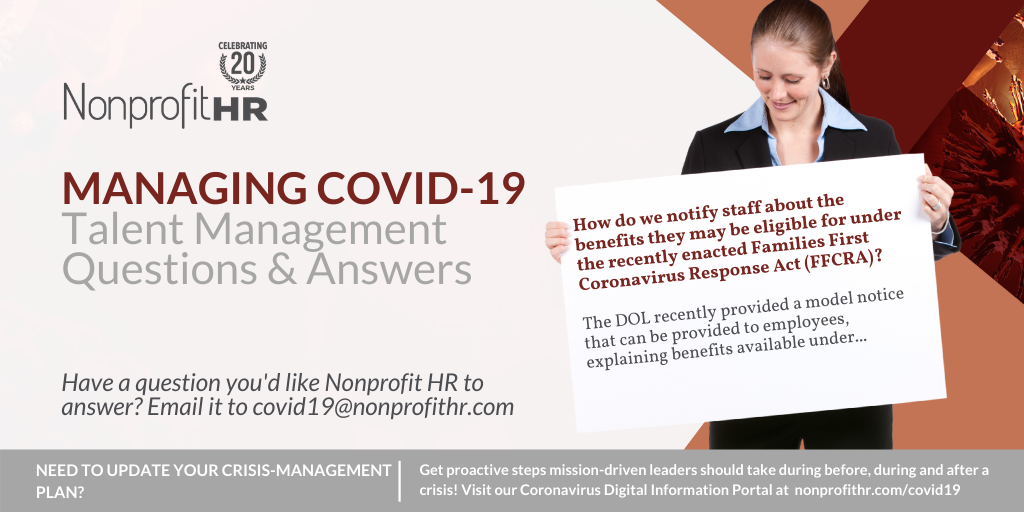
Nonprofit HR’s Response: The DOL recently provided a model notice that can be provided to employees, explaining benefits available under the Act. All covered employers should post the notice in a conspicuous place on its premises. Employers may also satisfy the requirement by emailing or direct mailing the notice to employees or post it on an employee information internal or external website. It should also be shared with new hires. The notice for non-federal employees can be found here: FFCRA Notice for Non-Federal
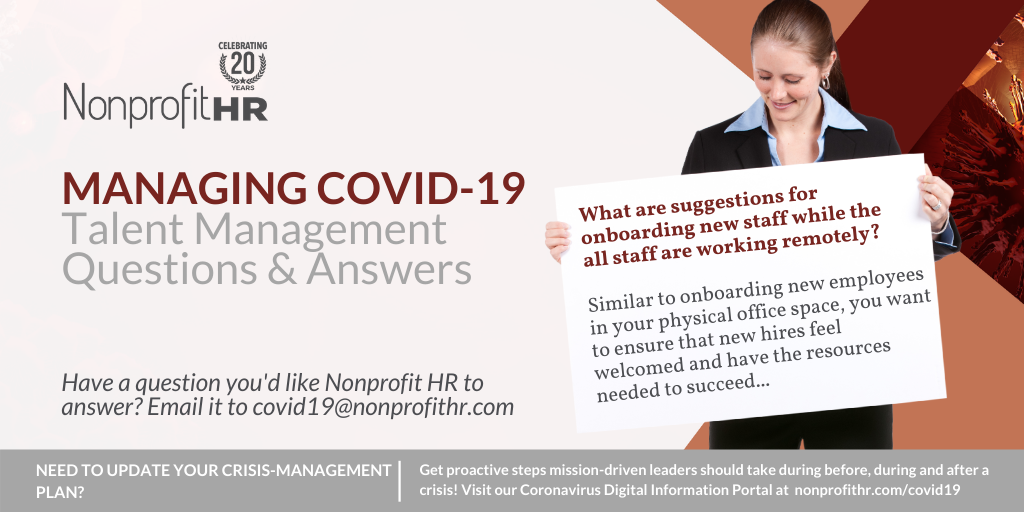
Nonprofit HR’s Response: Similar to onboarding new employees in your physical office space, you want to ensure that new hires feel welcomed and have the resources needed to succeed in their new role. Ensure that you have processes in place to set up and provide new employees with essential resources such as: laptops, videoconferencing tools, access to online resources/log-ins and new hire forms. (Note that the U.S. Department of Homeland Security just temporarily relaxed guidelines for reviewing I-9 documentation in person for those organizations that are currently operating in a full remote work environment due to the COVID-19 crisis.)
On the employee’s first day, utilize virtual meetings to review systems, processes, and benefits. Additional meetings over the following weeks should help the new hire learn more about your organization, receive guidance on key objectives and understand how you will measure success and outcomes for their role. Use videoconferencing as often as possible to assist new employees in building relationships with other colleagues across the organization. Instituting a buddy system in addition to daily meetings with their supervisor, will be key to bond them to the organization as they onboard during this time of uncertainty. It is important to communicate regularly and have open lines of communication throughout the day. Encourage new employees to initiate communication – “please reach to me when you need to.” Ensure that you familiarize them with the corporate culture, including sharing your organization’s values, acceptable behaviors, traditions and norms. Gathering feedback in real time about what they need to be successful and about the orientation process will be helpful as you continue to move forward in a virtual environment.

Nonprofit HR’s Response: If you have a workforce where most positions are conducive to telework, but a few are not, you should think creatively about how remote work can temporarily work for everyone. If you have a receptionist role, for instance, consider forwarding the office phones to that employee’s home line or cell phone. If you have an employee in a position that regularly works on tasks that are more on-site focused, consider some projects that they can work on while temporarily remote. Engage the entire team to think through the type of help they need in a virtual environment, as there may be different tasks that need attention and can be completed by these individuals. Ensure these staff have virtual access to systems as needed, and ensure they have adequate direction and guidance on tasks, just as they would when in the office. If nonexempt staff are working remotely, be sure to continue to monitor their hours so that you are in compliance with FLSA rules. And remember, encourage them to maintain regular work hours in an effort to ensure their mental health.

Nonprofit HR’s Response: Many employees are now faced with juggling working from home and looking after children or helping to managing their education. Employers should try to provide flexibility to staff during this time. If possible, allow such employees to work hours that are different than their usual work schedule, such as in the early morning, late at night or on the weekends in order to get their work done. Try establishing core hours during which a critical mass of staff are available but that allows for the flexibility that they might need to care for loved ones. If this is not feasible, give your employees the flexibility to use paid leave for some of the hours they cannot work. The key is communication with the employee’s supervisor and team members to ensure that work gets done.
Question: What is template for a Continuity of Operation & Recovery plan that can be adapted by nonprofit service providers?

Read more here:
https://www.nonprofithr.com/time-to-update-your-crisis-management-plan/
Additional guidance on business continuity can be found at:
https://nonprofitrisk.org/resources/e-news/no-business-continuity-plan-take-these-4-steps/
The Department of Homeland Security also has resources at: https://www.ready.gov/business-continuity-planning-suite
Hopefully you have a plan in place that can be tweaked as needed to respond to the current Cornavirus crisis and be able to continue to meet the objectives of your nonprofit’s mission.
Need direct advice from Nonprofit HR? Schedule a mini-consult!
Note: While Nonprofit HR is sharing answers with the public through this mechanism, these answers should not be wholly applied to any business and decision-making scenario organizations are facing. Organizations should partner with their Human Resources and talent management staff/consultants and advisors to create solutions for their unique challenges. No information shared on this page should be taken as Nonprofit HR direct advice for any challenges organizations are facing.


























